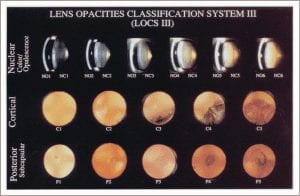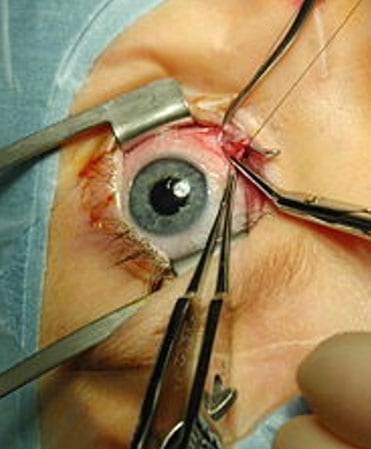Cataracts are opacification of the normally clear crystalline lens inside the eye. Our optometrist uses an internationally recognized classification system to allow tracking of progression of the opacity over time, whilst evaluating changes in visual acuity and contrast sensitivity.
As can be seen in in Lens Opacities Classification System image below, cataracts develop in different regions of the lens and vary in density and thus have varying effects on contrast and visual acuity. Some forms progress at faster rates than others, requiring more regular review.

Over time the clouded areas become larger and denser and cause the patient’s sight to become worse. The time taken for this to happen varies from a few months to many years. Usually cataracts affect both eyes, but often develop at different rates in each eye. The development of cataracts is a gradual painless worsening of sight. Other symptoms include blurred or hazy vision, spots before the eyes, double vision and a marked increase in sensitivity to glare.
An examination by our optometrist will reveal any changes that have occurred in the lens of the eye. We have special equipment that enables us to see changes in the lens that may lead to cataracts several years before symptoms appear. People older than 65 years often have signs of cataracts and should have their eyes examined regularly. If untreated, cataracts can cause blindness. Blindness can be prevented by detecting the cataracts early and, if necessary, by having them removed surgically.
Most patients have an intraocular lens (IOL) inserted at the time of surgery, with excellent results. This is a plastic lens that replaces your own cloudy lens. Patients may also need to wear spectacles or contact lenses.
Some surgeons now offer multi-focal, or extended focus intra-ocular lenses (MFIOL), allowing correction for both distance and near without glasses. These work to varying degrees of success with haloes around lights and decreased contrast sensitivity a common side effect. Generally, MFIOL work best for those who don’t drive much at night, are long-sighted, have regular corneal topography, healthy retinas, and have a relatively good tolerance to blur. Your suitability for a MFIOL should be discussed at length with our optometrists.
There is no proven method of preventing cataracts. Long term exposure to ultraviolet lights is thought to induce cataracts, so a brimmed hat and approved sunglasses should be worn in sunlight. Cataract surgery is performed when your vision interferes with daily life. We will assist you in making this decision. Cataract surgery is now a relatively minor procedure. Often it is performed under a local anesthetic on an out-patient basis. This means that the patient attends a hospital or clinic for the surgery and can go home the same day.
The surgery is performed by an ophthalmologist, a medical doctor who specializes in eye surgery. We will refer you to an ophthalmologist if necessary.
Dr Ieuan H. Rees. (Optometrist)
Buck & Todd Optometrist
Located at 103 Alfred Street, Mackay, 4740.

